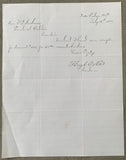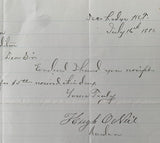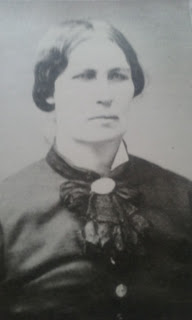O'NEIL, HUGH HAND WRITTEN & SIGNED LETTER (1881)
JO Sports, Inc.
Regular price $750.00
HISTORY: Hugh O’Neil. Born in Loughgee County of Antrim in Northern Ireland in 1831, he was proud of his family lineage and claimed descent from Red Hugh O’Neill. Hugh told his grandchildren of the banner of the O’Neil’s emblazoned with a bloody hand, and their battle cry “Red Hand to Victory”.

In preserved Montana history, the first mention of his name is in The Historical Sketch of Louis Maillet, which stated: Maillet spent the summer of 1857 in the Bitter Root, part of the time working on the new Fort Owens. In November, Hugh O’Neil and a man named Ramsey came from Walla Walla, on their way to Fort Bridger. They wished to reach Colonel Johnson’s (Johnston’s) command, but were ignorant of the way, and moreover were afraid of the Mormons.. O’Neil and his party therefore engaged Maillet to guide them to Fort Bridger. (In the course of travel they met Jacob’s) ….Jacobs gave such a terrible account of the Mormon scouting parties that O’Neil and his companions became discouraged and decided not to go on…O’Neil and Ramsey concluded to remain with Jacobs. This account is continued in A Sketch by Frank Woody, stating: …in the fall of this year, Hugh O’Neil and a man named Ramsey, came to Hells Gate from the Colville mines on the Columbia River, and were employed by Mr. Brooks to put up two buildings with the timber cut the previous winter.
The National Archives for Military Service Records was unable to find any record of service by Hugh O’Neil. He was referred to as Major which probably occurred because he was a freighter out of Fort Laramie, Salt Lake and Fort Floyd. Records show he ran an account at Fort Floyd at the same time as Fred Burr and Tom Adams.
All accounts, affirm that Hugh was a man of large proportions and possessed great strength and fortitude. This fact is further evidenced in his bare fisted boxing match with Con Orem, in Virginia City on January 2, 1865. A round by round description of all 185 rounds can be read in the historical writing titled The Frightful Punishment, (Warren J. Brier, 1969). The research for this book came from the published description of the pugilists endeavor written round for round by a reporter for the Montana Post, January 3-4, 1865.
Hugh was a true pioneer and as such, a politician and negotiator. One such instance where his skills were instrumental was in 1863 at Grasshopper Gulch. The story goes that he problem solved a rumor started by two Frenchmen that about two hundred Bannack Indians were stealing from a small group of miners. Fearing that the Indians would go on the warpath a relief party was sent out to escort a freighter outfit from Salt Lake that was due with sorely needed supplies. Hugh was elected Captain of the group. When they came upon a group of Indians, all disappeared except three, which included Pete and Jim, two Indians that had been employed with the freighter company. Buck Stinson and the other road agents in the party wanted to execute the Indians right there. Stinson it was believed would have killed O’Neil with a stray bullet during the execution. O’Neil was aware of the danger and the fact that the killing of the Indians could lead to an Indian war. O’Neil was able to convince all of the group, but the road agents, that the Indians were innocent and should not be killed. The Indian war was prevented, but the road agents did not forgive Hugh O’Neil. One of them later tried to kill him, during a boxing match in Helena. This story was cited in full in the February 27, 1895 Anaconda Standard.
Hugh was a devote Catholic, and credited with finding a place for Christmas Mass at Virginia City in 1865. The story told many times was documented in The Montana Magazine of History. Hugh O’Neil felt “it would be an everlasting shame if the Catholic religion could obtain no place for worship on Christmas Day”. Hugh went to the Acting Governor, Thomas Meagher and they formed a plan. By the end of the day, they found a building, remodeled it so well that it could no longer be a theater, and notified everyone in the area of the upcoming mass. The citizen’s of Virginia City and the surrounding area had a Christmas Mass in 1865, and had a church established and paid for by raw gold mined from this virgin earth, after the collection plate bought the building.
Hugh O’Neil ran for Sheriff of Deer Lodge County in 1865, and the election results were: Hugh O’Neil 788, Fred Burr, 835, C.S. Williams, nineteen. Newspaper articles state he served as Deputy Marshall for Missoula County (May 18,1874, Helena Herald) and as Warden of Deer Lodge Penitentiary (The River Press, June 29, 1881; New Northwest , November 25,1881). The June article states he was a guard at the prison before his appointment as Warden. Hugh also provided support for the Missoula sheriff as evidenced in this news item: “Fight or Run---Last week W. C. Taylor took it into his head that he could run the town. He managed to do so until shut off by Hugh O’Neil and Sheriff Pelkey…He was put under $500 bonds for assault with a deadly weapon and disturbing the peace (Missoula Pioneer, February 2, 1871)”

Family history says Hugh killed an Indian while trying to bring him into custody during his service as the Indian Agent in Missoula Montana in 1871. The fact he was an Indian Agent has not been verified.
Hugh married Margaret Pitt Meredith in 1858. She was born to Joseph Meredith from London, England and Marguarite Pitt Meredith from Wales, in Glen Morganshire, Wales, on June 18, 1844. Accounts in Montana historical documents of Margaret’s death cite they came to Montana by horseback in 1858. She is credited with being the first white woman to ride into Montana on horseback. The family story is that Margaret’s family was on a wagon train coming west, when they were attacked by Indians in what was believed to be present day Colorado. The only survivors were some of the young members of the wagon that had been hidden in the woods. These survivor’s, including Margaret were picked up by a Mormon wagon train and “one of the Mormon men wanted to add her to his already numerous list of wives.” The army was sent out to protect the wagon trains after the Indian attack and found the children, with the Mormon’s. They were taken back to Fort Bridger, where Margaret began a relationship with Hugh. They were married in Fort Bridger in 1858, by the military, then a Methodist minister they encountered (at an undocumented date or place) and finally by a Jesuit Priest. I assume that the Priest was Father Giordia in Virginia City. An article in the Butte Miner, January 24, 1915, declares her the first white woman in Montana, which is not true.
Margaret O'Neil
Margaret O'Neil
Margaret and Hugh had eight children: Jane, John, Mary Ellen (Ellen), Hugh, Mary, Adelaide or Adaline (Addie), Elizabeth (Liddie), and William (Willie).Willie died at the age of three years and five months, in 1877, from pneumonia. He is buried in the Philipsburg cemetery. Hugh and Margaret separated some time after moving to Philipsburg in 1875. and Hugh apparently lived in Philipsburg with daughter Jane and John Hickey, and in Deer Lodge.
The New Northwest, in Deer Lodge stated: “Mr. Hugh O’Neil and H. S. Neal are building substantial residences. The latter is on the west side, near the bridge, and the former in the southern part of town”, on July 15, 1881. In the Philipsburg items of The New Northwest, in 1882 was the statement: “…now under our new and elegant Kaiser House is the billiard hall and sample rooms presided over by Herman K., who as a very apt pupil of Hugh O’Neil, has attained such admirable proficiency, in the manly art as to make himself a terror to amateurs in the fist cuff line.” Then in October 1884, Hugh and Margaret were summoned for the sum of $700.00 for lack of payment on Lots 11 and 12 in Block 60 with improvements, at Deer Lodge, by Peter Valiton (New Northwest). The sheriff sale of the property has not been found.
Hugh, died of cancer at St. Patrick’s Hospital and was buried February 23, 1895, at St. Mary’s Cemetery in Missoula, Montana. The Democrat obituary had Hugh’s last name misspelled as O’Neal, but the history recited belonged to O‘Neil. “The deceased was a man of powerful frame in his younger days and many are the feats of strength, heroism, and endurance credited to him by his old time friends.” The February 28, 1895 P’Burg Mail, described Hugh’s funeral and family members that attended: “Mrs. L.C. Degenhart (Ellen) and sister Lydia O’Neil went to Missoula last Friday to attend the funeral of their father, Hugh O’Neil who died in the Sister’s hospital in that city last Thursday at the age of 64 years. The deceased was one of the best known pioneers of Montana having come to the state in 1861 (1857), and has ever since been associated with Montana history.
Offered here is a signed letter by Hugh O'Neil dated July 16, 1881 while he was working as warden.
FULL DESCRIPTION: This is a brief letter on white lined paper dated July 16, 1881. Hand written and signed in fountain pen, "Yours Truly Hugh O'Neil Warden." Clean front and back. Includes original folds Not torn. 9 3/4" x 7 1/2." Exceptionally rare autograph, one of three known.
Size: 7 1/2" x 9 3/4"
Condition: Very Good





